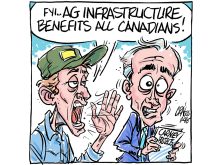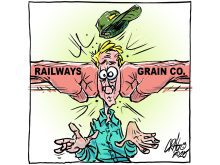In one hand is a set of rules designed to ensure that professional drivers of heavy trucks are rested and able to fulfil their duties safely.
In the other hand is a set of rules designed to ensure that livestock are humanely handled and delivered in good, marketable condition.
Both hands also hold the needs, and the perceived needs, of the public. These include public safety and the health of animals.
Trouble is, none of these rules were written in the same room, at the same time, by the same people. So the rules don’t serve anyone properly.
Read Also

Invigor Gold variety viewed as threat to condiment mustard
Invigor Gold, the canola-quality mustard developed by BASF, is on a collision course with Canada’s condiment mustard industry. It’s difficult to see how the two can co-exist.
On Jan. 1, new regulations came into play that require use of electronic logging devices for heavy trucks. Once these are activated and drivers begin their trips, there are no exceptions to the rules as they relate to hours of driving, resting or loading.
It has great potential to affect animal care as it relates to livestock transport drivers. Weather, downer animals, loading or unloading delays are not considered when it comes to the electronic record. Drivers are subject to fines if they breach the rules.
While the previous paper logs were guided by the same rules and subject to audits, they gave operators some flexibility, especially when they were close to their delivery or loading points. A truck loaded with livestock can’t stop for hours of rest in the same way as a dry van or flat deck can. The animals, like the driver, are on a time clock.
Drivers have no control over weather issues en route to their destinations and little control over loading or unloading delays.
Under the current rules, a driver can run out of hours while waiting at the packer’s in a lineup. While the delay might have started at an auction or feedlot, the rules don’t care. Without an exception to the regulations, the driver has to be taken out of service or be in violation. By the same token, the livestock’s mandated time without food, water and rest could be exceeded and the driver would also be in violation for that, but to a different area of government.
Commercial carriers can drive for up to 13 hours before requiring an eight-hour break. Live cattle are limited to 36 hours on the road before food, water and rest must be provided.
In Canada we have some of the longest trips between loading and unloading in the world. Across the top of the Great Lakes, the ability to offload animals is heavily restricted, but it is challenge regardless of location.
Until the various levels and branches of government, from the Canadian Food Inspection Agency to Transport Canada and the provinces can coordinate their rules, the Canadian Cattle Association and other industry and veterinary organizations are asking that animal welfare be recognized as an emergency exception to drivers’ service limits.
If governments can’t or won’t be practical, there will be fewer transportation companies and fewer drivers willing and available to move livestock. Prices will increase for animal hauling, but given the current and ongoing shortage of drivers and trucks, there could be a failure of the system to handle these critical food supplies.
The United States has an exemption for livestock drivers’ on-duty time if they are within a 150-mile (241 kilometre) radius of either the origin or destination. For ease of legislating, Canada would do well to harmonize its regulations to that standard.
Karen Briere, Bruce Dyck, Barb Glen and Mike Raine collaborate in the writing of Western Producer editorials.















